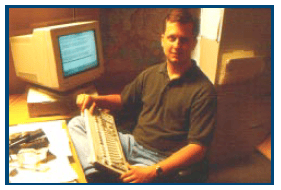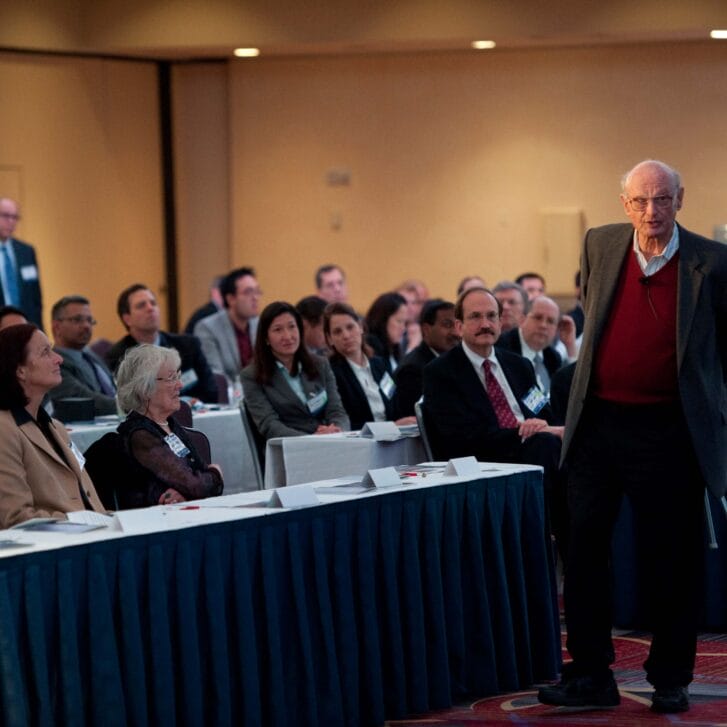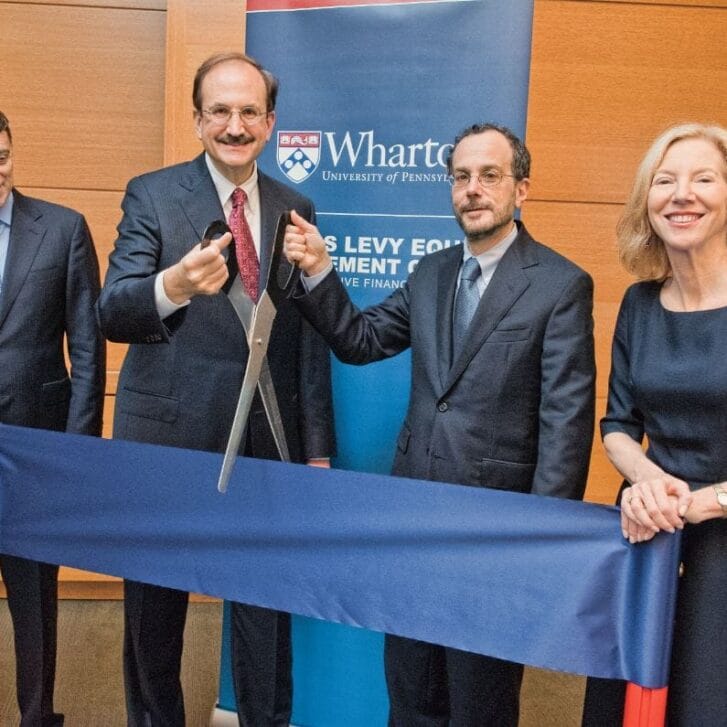Chatting Long-Distance on the Internet
In early 1994, Richard Ahrens, W’96, began to wonder if there was some way to cut down on the huge telephone bills he was racking up talking to friends at other colleges.
The question eventually led to the development of Internet Voice Chat (IVC), a computer program which allows users to speak to each other — with their real voices — using their Internet accounts.
By working up to 10 hours a day in his dorm room, Ahrens, an information systems and finance major, finished the program in May of last year, one day before he left for summer vacation at his home in Middletown, N.J.
The response to his software program was overwhelming from the start. Even before finetuning IVC, Ahrens was flooded with e-mail from Internet users wanting more information.
“I heard from research professors, Internet service providers, venture capitalists and even someone from NASA,” says Ahrens. “I realized this was probably a very good business opportunity.”
IVC is simple to use, says Ahrens, who compares it to operating a CB radio. The user records a message using IVC, then sends the voice transmission to another Internet user anywhere in the world. The second user receives the message within seconds, and can reply using his or her own IVC program.
And since IVC shoots the messages across the Internet instead of long distance carriers’ cables, each exchange is free. In addition, IVC has an answering machine and call screening, as well as sound quality that Ahrens says is better than a telephone.
“It’s the same cost if you are talking to someone down the hall or in China,” Ahrens say. “If you are making tons of long distance calls, the program can literally pay for itself in one day.” He envisioned IVC being used for such things as professors talking to colleagues at remote universities, parents talking to their college kids via a home dialup Internet connection, and corporations offering voice tech support on the Internet.
A limited version of the software was made available to Internet users free during a 30-day evaluation period. Users were then expected to discontinue the program or pay a $25 fee. (Many kept the program, but didn’t pay the fee, Ahrens notes.) He also began to negotiate site licenses with companies and universities.
All that came to an end two months ago when he decided to sell the program to a private company. “It’s a win-win situation,” says Ahrens, who is working this summer for J.P. Morgan in its corporate technology group. “I am very satisfied with the price, and the company is getting an excellent product.”
Good Teaching Rewarded
Every spring, both undergraduate and graduate students at Wharton take an opportunity to salute excellence in teaching.
Among the most prestigious honors is the David W. Hauck Award for Outstanding Teaching on the undergraduate level, given to two faculty members for their ability to “stimulate and challenge students, their knowledge of cutting-edge research and their commitment to educational leadership.”
This year, the recipients, each of whom receives $15,000, were Richard Herring, professor of finance, and Larry Hunter, assistant professor of management.
On the graduate level, the Helen Kardon Moss Anvil Award – given for teaching quality and commitment to students – went to David Reibstein, professor of marketing. Reibstein, who has been teaching at Wharton since 1980, is a former vice dean and director of the Graduate Division.
Also on the graduate level, eight faculty won 1995 Excellence in Teaching awards on the basis of student course evaluation ratings. The professor with the highest rating among the eight also receives the Class of 1984 award.
This year, for the third time in a row, the Class of 1984 winner was William Tyson (Legal Studies). The other seven winners included: Jamshed K.S. Ghandhi (Finance), Howard Kaufold (Finance), Peter H. Knutson (Accounting), Richard Shell (Legal Studies), Jeremy Siegel (Finance), Robert Stine (Statistics) and Michael Useem (Sociology and Management).
On the undergraduate level, 10 faculty received teaching awards: Jamshed K.S. Ghandhi (Finance), William F. Hamilton (Management), Richard Herring (Finance), Larry Hunter (Management), Robert Inman (Finance), Philip Nichols (Legal Studies), Georgette Poindexter (Real Estate), Diana C. Robertson (formerly Legal Studies), Abba Krieger (Statistics) and Jeremy Siegel (Finance).
Say It With Videos
In conjunction with WGBH in Boston, Wharton Executive Education has created a new video series with individual presentations on marketing, management, and finance and accounting.
“The videos are done in a documentary format, with narration, case studies and workplace interviews,” says Jeff Barta, assistant director, marketing. The four videos include:
– Creating Customer Value: The Essentials of Marketing, led by Barbara E. Kahn, associate professor of marketing
– Achieving Competitive Advantage, led by Harbir Singh, associate professor of management
– Achieving Competitive Advantage: Managing for Organizational Effectiveness, led by Michael Useem, professor of sociology and management
– Finance and Accounting for the Non-Financial Manager, led by Peter H. Knutson, associate professor of accounting
Part of the marketing video, says Barta, is filmed inside companies like Visa International, Ryka and the Bank of Boston, as well as at an athletic wear tradeshow in Atlanta. Because WGBH is co-producing the videos, much of the production work will be done in Boston, with final edits in Philadelphia.
Available August 1, each video costs $195, any two together cost $350, and the set of four costs $595. For information or to order, call 1-800-255-3932.
What’s New: The Wharton Information Network
Are you interested in what the Wharton Club of Japan is up to — or in career management programs sponsored by the Wharton Club of Washington, D.C.? What about executive education courses or the latest in Wharton faculty research?
For alumni interested in viewing Wharton information and selected publications, the School now offers the “Wharton Information Network” on the Internet.
The address for The School’s World Wide Web “home page” is http://www.wharton.upenn.edu
To access the home page, you need an Internet connection and a web browser such as Mosaic, Netscape Navigator or Lynx. (Lynx provides text-only access; Mosaic and Netscape offer full graphics with pictures, colors and fonts.) In addition, certain publications require use of an Adobe Acrobat viewer — a portable document format package which offers exact replicas of the printed page. For information on downloading a free copy of Acrobat Reader, select the question mark icon on Wharton’s home page.
Already available on the “Wharton Information Network” are several publications, including the “State of the School” annual report, the Guide to Faculty and “Wharton Impact” (a newsletter on faculty research). Also online are the Executive Education catalog and the MBA Student Resource Guide & MBA Placement Survey.
In addition, you can access the Wharton Alumni Magazine and information about the Wharton club network, including a schedule of domestic and international club events, along with updates on special programs like Alumni Weekend 1996.
Any documents accessible through the home page can be printed by the user.
Wharton Alumni Affairs has its own e-mail address — alumni.affairs@wharton.upenn.edu — for use by graduates and students.
Expanded offerings of the home page are under development. Users will eventually find links to Wharton divisions, student organizations, academic departments and research centers, as well as information about careers and job-related resources.
Good News, Again
In its 1995 survey of business graduate schools, U.S. News & World Report ranked Wharton second, two tenths of a percentage point behind M.I.T. (Sloan), and ahead of Stanford (third place), Harvard (fourth) and Northwestern (fifth). Two years ago, Wharton had placed fourth.
The poll also ranked Wharton’s academic departments among the top five in 9 of 11 categories — more than any other school. Wharton ranked number one in finance, real estate and business law, and among the top five in the areas of accounting, international business, non-profit organizations, marketing and general management.
In a separate Executive Education ranking, the School tied for first place with Harvard and Kellogg. Two years ago, the School had ranked sixth.
In Business Week magazine’s 1994 biennial survey of business graduate schools, Wharton was ranked number one, up from number four in 1992.
 With Highest Honors
With Highest Honors
Lewis E. Platt, WG’66, chairman, president and CEO of Hewlett-Packard Co., has been elected to Wharton’s Alumni Honor Roll. Students selected Platt the 1994-95 Outstanding Alumnus from a slate of five finalists chosen for their outstanding contributions to the School and society.
Undergraduates Make Their Case
Wharton undergraduates came close to batting one thousand in four business case competitions this spring.
 At The McIntire International Case Competition, held every year at the University of Virginia in Charlottesville, a Wharton team placed first, outperforming three other finalists.
At The McIntire International Case Competition, held every year at the University of Virginia in Charlottesville, a Wharton team placed first, outperforming three other finalists.
At the 1995 National Business Challenge, held at the University of Texas at Austin, Wharton came in second place overall out of 12 schools. In a separate poll, students who took part in the competition rated the Wharton team first.
In the First Annual Philadelphia Area Case competition at Temple University in Philadelphia, Wharton sophomores beat out four other local university teams. In The Harold Crookell Honors Business Administration International Case Competition at the University of Western Ontario, a Wharton team won against four others from Switzerland, Singapore, Finland and Belgium.
“We were asked to look at a Canadian company that was debating whether or not to expand into Mexico and then into other international markets,” says Anand Desai, a Wharton junior who was part of the winning team. Over the course of three days, the students were allotted exactly 14.5 hours to come up with a business strategy that would take advantage of the new market opportunities. Each team presented its plan on paper and then defended it before a panel of five judges. “The judges had prepared for the session just as vigorously as we had,” says Desai. “It was a great experience.”
Other members of the Wharton team included seniors Shannon Fullerton, Elizabeth Fuss and Vasan Kesavan.
Consulting Still #1
The consulting industry has once again attracted the highest number of new MBA graduates, followed by the investment banking/brokerage industry and commercial banking.
According to preliminary figures from Wharton’s Career Development & Placement office, 27.35 percent of WG’95 graduates accepted jobs with consulting firms, compared to 23.5 percent in 1994. Investment banking/brokerage hired 16.7 percent of the class compared to 19.8 percent in 1994, and commercial banking hired 13.4 percent compared to 10.6 percent.
On-campus recruiting services hosted 6,054 company interviews, an increase of 8.6 percent over 1994.
A full report on both graduate and undergraduate job placement will appear in the next issue.
Campus News
– Professor W. Bruce Allen has been appointed Vice Dean and Director of the Graduate Division. He replaces Isik Inselbag, who held this position since 1991 and who will now resume his teaching responsibilities in the Finance Department. Allen, who is professor of public policy and management, has been closely involved in the Graduate Division through his work on the Graduate Curriculum and Implementation Committees and other initiatives. During the last year, he served as Vice Dean and Director of the Whar ton Undergraduate Division. Richard J. Herring, professor of finance, replaces Allen as Vice Dean and Director of the Undergraduate Division. Herring was chair of the Undergraduate Curriculum Committee during 1993-94, and has been the Finance Department’s departmental adviser for undergraduate course offerings. Mark V. Pauly, Bendheim Professor of Health Care Systems, public policy and management, and research director of the Leonard Davis Institute, is the new vice dean and director of Wharton’s Doctoral Programs. He replaces David C. Schmittlein, professor of marketing, who has been both vice dean of the program and chair of the Marketing Department. Schmittlein will continue on as department chair.
– Jon Huntsman, W’59, chairman and CEO of Huntsman Chemical Corp., delivered this year’s MBA commencement address on May 22. Huntsman, a highly-respected entrepreneur, philanthropist and member of Wharton’s Board of Overseers, built Huntsman Chemical Corp. into one of the world’s largest producers of plastics and specialty chemicals with annual revenues of close to $4 billion.
– With the increasing convergence of the manufacturing and service sectors, the need for organizations to analyze their sourcing, production, distribution and customer support systems is becoming more and more critical. To address these issues, Wharton has announced the formation of the Fishman-Davidson Center for Services and Operations Management. The new center will examine the service functions of manufacturing companies and the operations functions of service firms in industries as diverse as financial services, computer products, chemicals, automobiles, insurance and hospitality. Center co-directors are Morris A. Cohen, Matsushita Professor of Manufacturing and Logistics, and Marshall L. Fisher, Stephen J. Heyman Professor. Both professors are in the Operations and Information Management Department.
– Nationally prominent health care providers and policy analysts discussed the changing dynamics of the health care marketplace at a daylong conference in April. Sponsored by the Leonard Davis Institute of Health Economics, the conference focused specifically on the impact of market changes on the Philadelphia region and compared Philadelphia to other regions across the U.S. Participants also discussed the effect of the unprecedented shifts in health care on consumers, providers and medical centers.

























